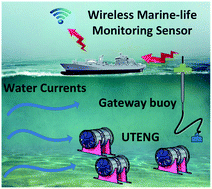Self-powered wireless sensing platform for monitoring marine life based on harvesting hydrokinetic energy of water currents
Abstract
The continuous flow of ocean currents moves a large amount of water across the earth's oceans, creating a great source of energy that is ready to be captured. Here, we present an energy harvesting technology based on underwater triboelectric nanogenerators (UTENGs) to generate electricity from the kinetic energy of near-surface water waves, currents, and tides. Unlike earlier literature in the field that focused mainly on harvesting energy of the ocean waves where the devices are deployed on the surface, the current work deals with underwater currents as a potential energy source. The UTENG operates in a free-standing mode with low-cost fabrication and high throughput from incidental water currents. A single unit of the device consists of four UTENG components connected in parallel for use within the neritic zone of the ocean. This hybridized structure can attain a voltage of nearly 400 V, whereas the generated power is 200 mW. The harvested power is utilized to power pH and turbidity sensors for environmental monitoring of oceanic waters. Interestingly, the observed hydrokinetic power performance is among the highest achieved with TENG technology, suggesting its potential for applications in self-powered marine life monitoring networks and the internet of things.



 Please wait while we load your content...
Please wait while we load your content...